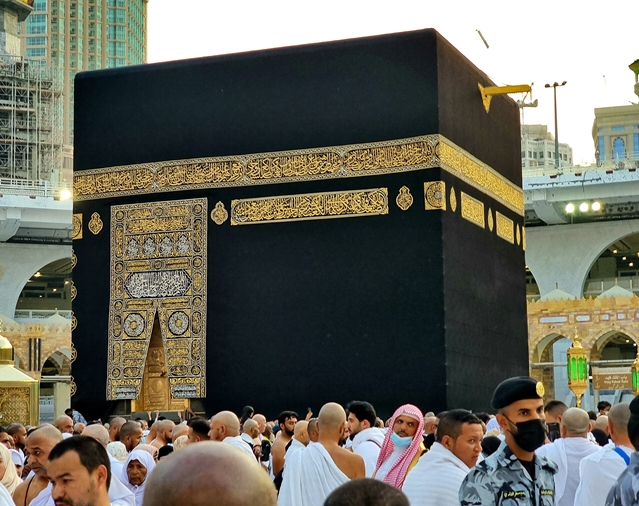Definition:
The Kaaba is a cube-shaped building located in the center of the Masjid al-Haram in Mecca, Saudi Arabia. It is the most sacred site in Islam and serves as the qibla (direction of prayer) for Muslims worldwide. The Kaaba is covered with a black silk and gold curtain known as the kiswah and is circumambulated by pilgrims during the Hajj and Umrah rituals.
Etymology:
The word “Kaaba” (الكعبة) comes from the Arabic root “ك ع ب” (k-‘-b), which means “cube” or “something with an elevated structure.” The name reflects its cubic shape. In pre-Islamic times, it was known by various names, but the term “Kaaba” became predominant in Islamic tradition.
Description:
The Kaaba is approximately 13.1 meters (43 feet) high, with sides measuring about 12 meters (39 feet) by 10.5 meters (34 feet). It is constructed of granite from the surrounding hills of Mecca. A notable feature of the Kaaba is the Black Stone (al-Hajar al-Aswad), which is embedded in its eastern corner. The Black Stone is revered by Muslims, and pilgrims attempt to kiss or touch it during the Tawaf (circumambulation).
The interior of the Kaaba contains a marble floor and three wooden pillars that support the roof. A small golden door called the Bab al-Tawbah (Door of Repentance) leads to the inside, but entry is restricted to select individuals for maintenance and religious purposes.
Symbolism:
The Kaaba is claimed to symbolize unity, as it serves as the single focal point for Islamic prayer, emphasizing that all Muslims, regardless of race or nationality, worship one God (Allah). It also represents the monotheistic traditions of Abrahamic faiths, as it is believed to have been built by Prophet Abraham (Ibrahim) and his son Ishmael (Ismail).
Many people, particularly outside of Islamic scholarship, claim the Kaaba is a symbol of Allah Himself. However, this is not the mainstream Islamic understanding. Islamic theology strongly emphasizes that Allah is beyond physical form and that no object, including the Kaaba, can represent Him. Associating Allah with a physical object would contradict the Islamic principle of Tawhid (the absolute oneness of God), which strictly rejects any form of idolatry. However, many argue that the Kaaba, as a sacred structure, symbolizes the limitations of human understanding of Allah—that is, that humans require physical reference points to help them grasp the concept of divine presence.
Circumambulation, known in Arabic as Tawaf (طواف), is the ritual act of walking around the Kaaba seven times in a counterclockwise direction. It is a fundamental part of the Islamic pilgrimage, performed during Hajj and Umrah. In occult symbolism, the black cube symbolizes Saturn, which is also associated with Satan. Circling around the Kaaba is seen as symbolizing Saturn’s rings, which represent imprisonment. Both Saturn and Satan are referred to as the “Lord of the Rings,” meaning the Lord of Imprisonment.
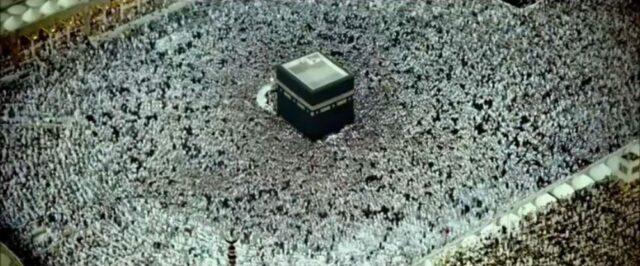
Circumambulation around the Kaaba symbolizes the chaotic and hypnotic nature of an ant mill, a phenomenon where army ants march in a continuous loop until they collapse from exhaustion. Just as the ants are trapped in an endless, self-reinforcing cycle, worshippers circling the Kaaba move in a ritualistic pattern, driven by tradition and collective momentum.
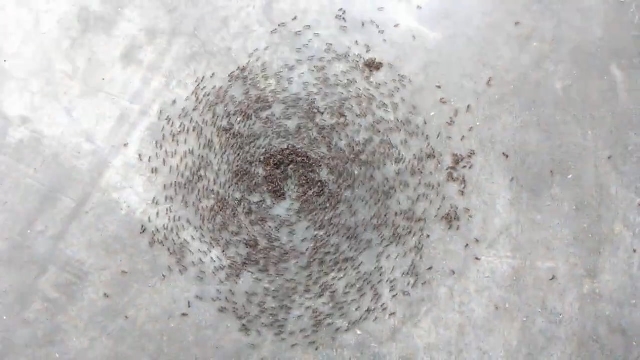
Interestingly, this circular movement around a central object is not exclusive to Islam. For instance, Christians, too, partake in a similar practice during Christmas, gathering and moving around the Christmas tree, which, unlike the Kaaba’s cube, takes the form of a cone. Both rituals involve a form of reverential orbit, with adherents drawn into a cyclical pattern around a sacred structure, echoing primal behaviors found in nature.
Christians typically sing “Here We Go Round the Mulberry Bush” while circling the Christmas tree. The Norwegian version of the song replaces the lyrics “On a cold and frosty morning,” or in some versions “Early in the morning,” with “Early a Monday morning.” The phrase is then changed to a different day of the week in each verse, resulting in seven verses—similar to how Muslims circle the Kaaba seven times.
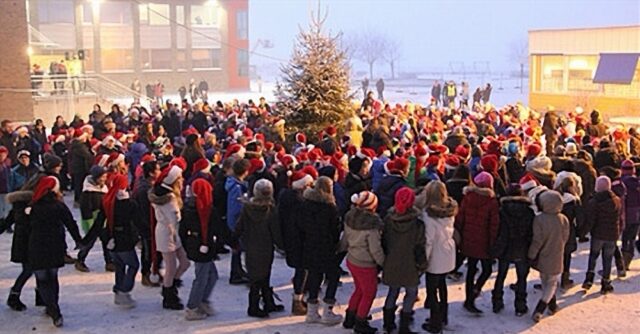
Underneath the Kaaba’s Kiswah (black cloth covering), we can see that it’s constructed from bricks, much like the Illuminati pyramid, which is also composed of stacked bricks. Bricks are often associated with imprisonment and slavery—as seen in historical narratives where enslaved people were forced to make bricks for oppressive regimes. Just as the Illuminati pyramid is built brick by brick, representing hierarchy and control, the Kaaba’s brick structure can similarly evoke themes of confinement and servitude.
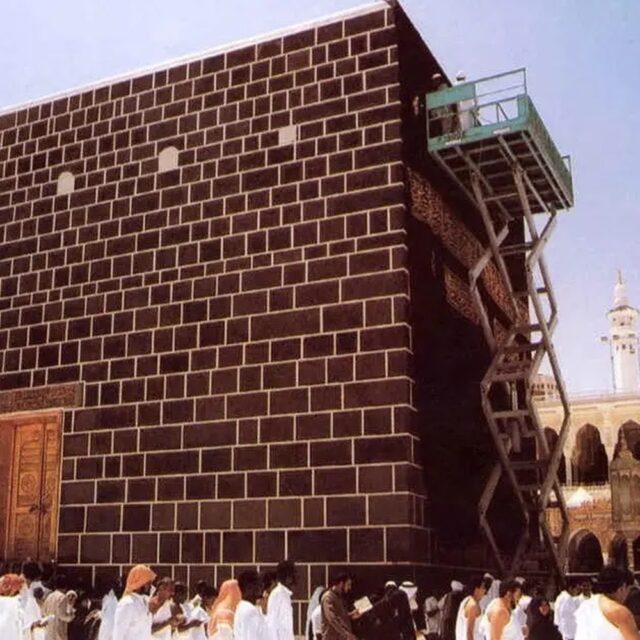
The Kaaba door is an ornate, golden entrance located on the northeastern wall of the Kaaba. Originally made of wood, it has been replaced multiple times over the centuries and is now crafted from pure gold. Positioned above ground level, the door requires a staircase to access, symbolizing the hierarchical ascent found in structures like the Illuminati pyramid or the stairway to heaven—where one must “climb the corporate ladder” of language, money, power, and information in pursuit of divine truth, only to realize it was all an illusion.
In practice, only a select few, such as high-ranking officials and invited guests, are permitted to enter the Kaaba on special occasions. However, symbolically, all Muslims praying toward the Kaaba express a deep longing to enter it. Yet, upon stepping inside, one is merely walking into a cube—a stark, enclosed space that serves as a metaphor for the imprisonment of belief, where the ultimate realization is not divine enlightenment but the confines of a system built on constructed authority and controlled access to the actual workings of language and the world.
The door itself carries symbolic meaning, often representing spiritual death and the ability to transition between dimensions of language—the shift from illusion to realization. To pass through a door is to grasp something hidden, to understand a lie for what it is. Yet, doors can also be locked, reinforcing the imprisonment symbolism of the Kaaba. The restricted access to its golden door mirrors the way language, knowledge, and power are controlled, ensuring that only a select few ever step beyond the threshold.
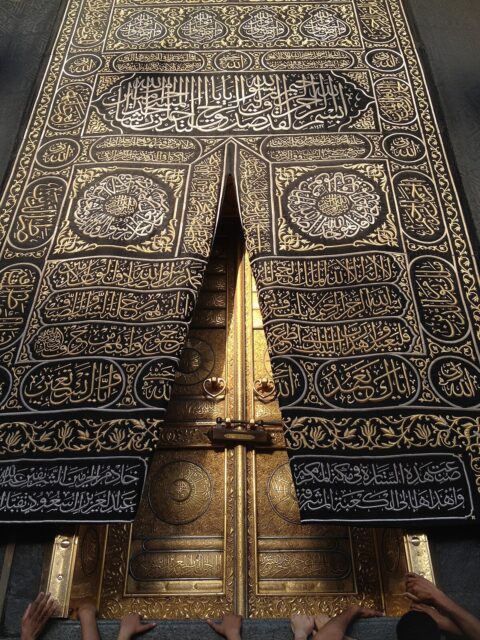
The Black Stone (al-Hajar al-Aswad) is a revered object embedded in the eastern corner of the Kaaba. Muslims believe it was sent down from paradise and that it once shone pure white before turning black due to the sins of humanity. Pilgrims performing Hajj and Umrah attempt to touch or kiss the stone, as it is considered a sacred relic that carries spiritual significance.
Symbolically, the Black Stone is a solid, unmoving object, firmly set within the Kaaba’s structure. Its lack of movement represents imprisonment, as it remains fixed in place, unable to act or change. In this way, it mirrors the concept of being bound by belief, where faith, like the stone, is held in place by tradition and reinforced through ritual.
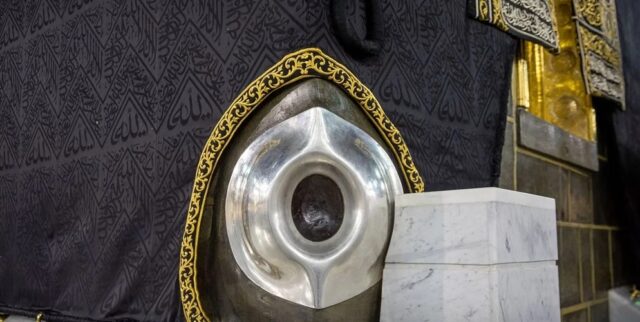
The inside of the Kaaba is a small chamber with a simple design. Unlike its grand exterior, the interior is minimalistic, featuring white marble walls, a marble floor, and three wooden pillars supporting the roof. The ceiling is also made of wood, and golden lamps hang from above, adding a dim, reverent glow to the space.
There are no furnishings or decorations, except for a small altar and inscriptions on the walls containing verses from the Quran. The walls are painted in a two-tone institutional paint scheme—white on the lower half and green on the upper half—a design commonly found in prisons and psychiatric facilities, further emphasizing the imprisonment symbolism of the Kaaba.
As entering the Kaaba is known to represent stepping into the heart of the belief system, the three pillars inside, which support the ceiling, symbolize the number 3—also known as the trinity, which forms the core structure of language.
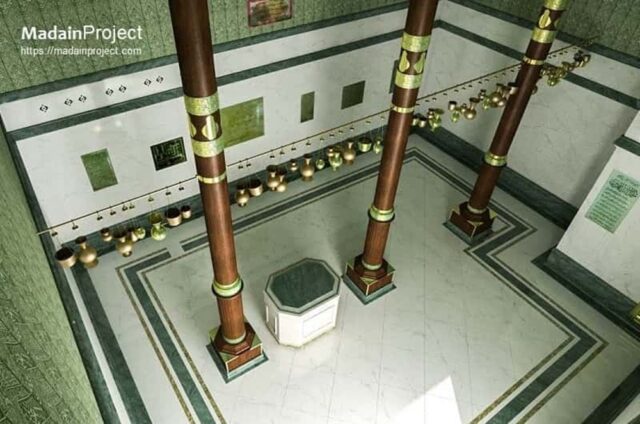
Religion:
The Kaaba is mentioned in several places in the Quran:
In Surah Al-Imran 3:96, it says: “Indeed, the first House [of worship] established for mankind was that at Bakkah [Mecca]—blessed and a guidance for the worlds.”
In Surah Al-Baqarah 2:125, it says: “And [mention] when We made the House a place of return for the people and [a place of] security. And take the standing place of Abraham as a place of prayer.”
Several hadiths emphasize the sacredness of the Kaaba. In Ibn Majah, the Prophet Muhammad (peace be upon him) is reported to have said: “The reward of performing one prayer in the Masjid al-Haram is equal to 100,000 prayers performed elsewhere.”
The black stone is also mentioned in hadith. In Tirmidhi, it says: “The Black Stone is from Paradise, and it was whiter than milk, but the sins of the sons of Adam made it black.”
